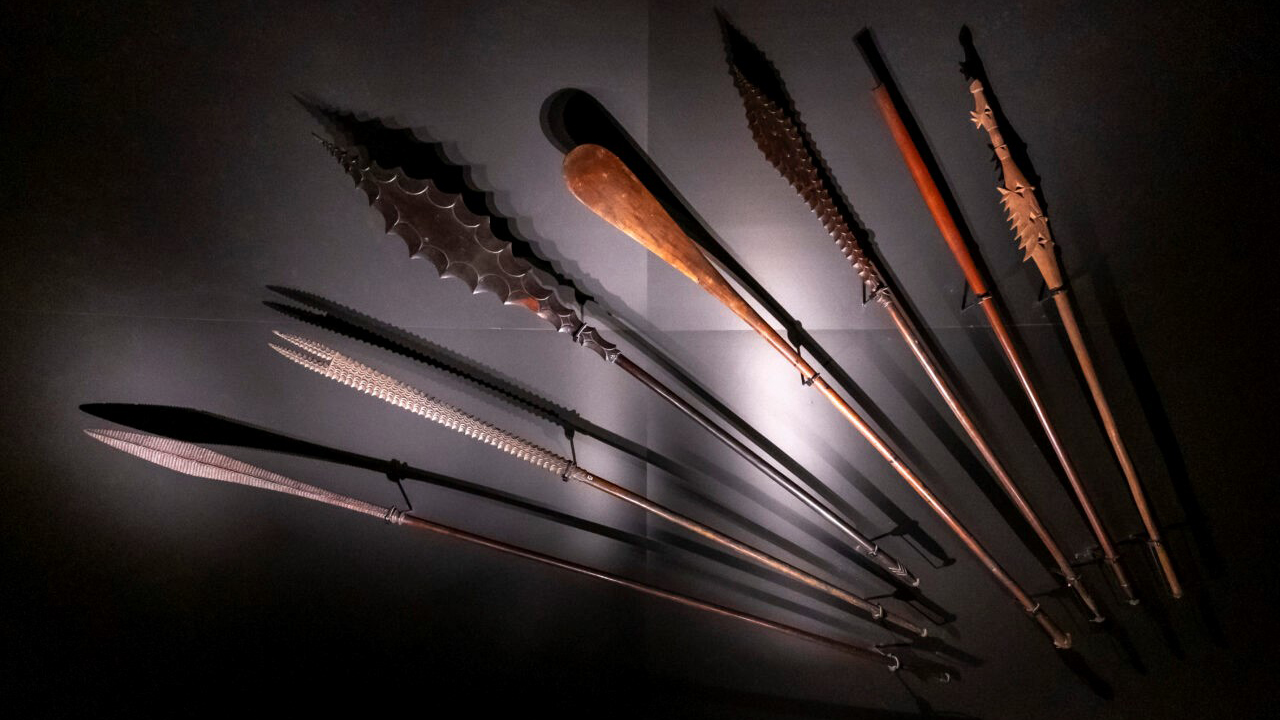‘Akatara from Cook Islands on exhibit in Venice
Saturday 11 December 2021 | Written by Rod Dixon | Published in Art, Features

Above - From left – the second, third and fifth items on display are Cook Islands’ ’akatara. 21121047
An exhibition in Venice exploring the sculptural beauty of command clubs from Oceania, including the Cook Islands, has inspired a Rarotongan experiment to discover how ancient weapons obtain their beautifully finished surfaces.
The Palazzo Franchetti in Venice is currently hosting an exhibition entitled Power & Prestige: the Art of Clubs in Oceania. Devoted to objects symbolising power and prestige in Oceania, it includes a number of ‘akatara from the Cook Islands.
The exhibition has been organised by the Fondazione Giancarlo Ligabue in collaboration with the Musée du Quai Branly-Jacques Chirac in Paris. It is curated by Professor Steven Hooper, a specialist in Oceanic art at the University of East Anglia in the UK.
Steven Hooper told Cook Islands News the origins and purpose of the exhibition. “I have been studying art from Oceania for fifty years and there has never been an exhibition that focuses on ‘clubs’, yet museum storerooms all over the world, including in the Pacific, are full of them.”
“They were made in almost all Oceanian cultures and we wanted to bring them out of the storerooms to show that they were not just weapons – many of them were probably never used in combat – but are remarkable sculptures that served as exchange valuables, dance accessories, authority staffs and sometimes as god images from the pre-Christian era.”

“If you just needed a stick with which to hit someone,” says Hooper, “you didn’t need to go to all the trouble to make these extraordinary sculptures with their beautifully finished surfaces and complex shapes. Something more profound was going on.”
The exhibition hopes to challenge simple explanations and present these neglected artworks as sculptures worthy of global attention.
“We have included several examples from the Cook Islands because the craftsmen of the late eighteenth and early nineteenth century made exceptionally beautiful staff clubs,” says Professor Hooper.
In advance of the exhibition he contacted Jean Mason at the Cook Island Library and Museum Society for the names of certain Cook Islands weapons included in the exhibition. Mason says she wasn’t fazed about getting involved in what is traditionally considered a man’s “area of expertise”.

“I think you can say with confidence this knowledge has been utterly lost in the Cook Islands,” says Mason. “There are no men I know, living today, who have the knowledge of traditional Cook Islands weaponry nor the battle techniques they employed. I was always interested in this area because so very little is known or has been written about it.”
As part of her research, Mason is collaborating with local ta’unga Henry Tavioni on an experiment to determine how ancestors achieved the patina, which makes the polished wood of Cook Islands weapons look as if they were made from iron.
“We started by soaking freshly made weapons (clubs and short spears carved by Henry) in a taro patch for one month, four months and six months, respectively,” says Mason.
“So far we have removed the items that have been immersed for one month and four months; other items remain in the mud, as the experiment is not yet completed.

“It seems that one month is insufficient time for producing a shiny patina even when polished; the artefact still showed pink (wet wood) under the black skin when given fresh carved patterns. After four months some of the thicker parts of the wood showed pink under the black skin when carved. It is obvious then that a thinner implement will absorb more mud to give it the deep black colour in a short time, while thicker implements take longer. The experiment is ongoing. We might carry on for one year to see the effect. It’s believed this is how long Atiuans, in the past, kept their weapons in mud.”
Experiments such as these are what Professor Hooper hoped for, as a spin-off of the Venice Exhibition. “It will be very good,” he says, “if the exhibition and its accompanying book stimulate research on this topic in the islands, especially to recover the lost knowledge of techniques that were used to create them.”
Hooper says that, when the Covid 19 pandemic recedes, a similar exhibition may be shown in the Pacific region.
The Venice exhibition includes 126 artworks from places as far apart as Rapa Nui, Hawaii and West Papua, and is on display in Venice to 13 March 2022, after which it moves to the Musée du Quai Branly-Jacques Chirac in Paris from 8 June to 25 September 2022.

For the opening celebrations, thirteen members of Ngāti Rānana London Māori Club were invited to Venice to inaugurate the exhibition with a tapu-lifting ritual and haka for guests.












































